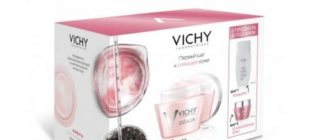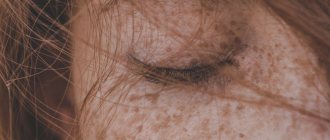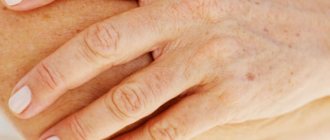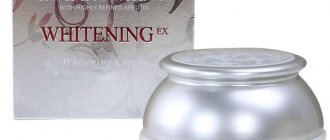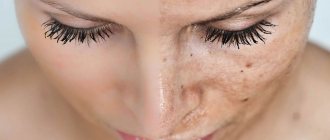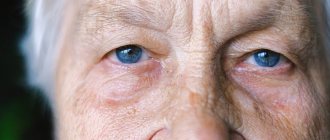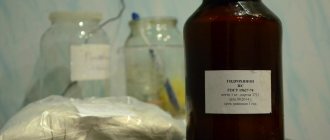Causes of pigmentation
The color of our skin, hair and eyes is determined by special cells - melanocytes, which produce the pigment melanin. These cells are susceptible to hormonal, physiological and external changes, to which they can respond by excessive production of melanin and its uneven distribution throughout the epidermal cells, resulting in the appearance of age spots.
Excess pigmentation can be caused by:
- Hormonal changes during pregnancy or menopause
- Long and frequent exposure to the sun without sunscreen cosmetics
- Cosmetics containing alcohol, mercury compounds, some essential oils
- Taking certain medications
- Injuries, burns
Ochronosis
Changes in skin color also occur in the case of so-called ochronosis. This disease is quite rare and is a specific lesion of cartilage, ligaments and tendons, expressed in slowly increasing immobility of the spine with deforming arthritis, otosclerosis, and damage to the cartilage of the larynx. The fabrics are painted in dark colors - ash-gray, brown or almost black. Such changes are also observed on the eyelids. In mild forms of ochronosis, the condition is limited to skin hyperpigmentation and the disease ends in recovery. In severe cases, a change in the color of the skin of the eyelids is accompanied by a spotty dark color of the mucous membrane of the eyes in the area of the palpebral fissure along the limbus. The disease is accompanied by alkaptonuria. The color of the skin during ochronosis is due to the deposition of ochronotic pigment in it. Ochronosis of an exogenous nature can also occur with phenol poisoning or long-term use of carbolic acid for medicinal purposes. The course is chronic.
Treatment: shock doses of vitamin C, measures aimed at reducing alcantonuria.
Advantages of pigmentation treatment at ART Clinic
Online consultations for patients from the regions
A team of highly qualified specialists with extensive experience
Modern minimally invasive techniques of operations and reconstructions
Affordable prices, promotions, discounts, installments
At the ART Clinic, pigmentation treatment is carried out by highly qualified specialists. Their knowledge and experience, combined with modern hardware techniques and a variety of cosmetology equipment at the clinic, ensure high effectiveness of treatment and eliminate the occurrence of side effects.
Sign up for a consultation at the ART Clinic by calling 8 800 500 42 32 (toll-free within Russia) or using a special form.
Our specialists
Slide
Ignatieva Elena Alexandrovna
Doctor - cosmetologist
Grebenshchikova Alexandra Igorevna
Doctor - cosmetologist
Kalinina Olga Alexandrovna
Doctor - cosmetologist
Bogdanova Yulia Andreevna
Doctor - cosmetologist
Kalinina O.A. Doctor - cosmetologist
Removal of pigmentation using BBL meth at ART-Clinic
Many people have experienced excessive pigmentation. The reason for the appearance of freckles, “solar lentigo”, and age spots is the accumulation of melanin. It is possible to disguise problem areas of the skin using decorative cosmetics, but this method is not suitable for everyone. Removal using BBL HERO is much more effective. This hardware technique is absolutely safe. It allows you to lighten your skin in just a few treatments.
Removal of age spots using the latest BBL HERO method is a non-invasive, painless and ultra-fast procedure that allows you to effectively remove almost any hyperpigmentation on the face and body!
BBL HERO allows you to remove hyperpigmentation caused by pregnancy, pathologies of internal organs, menopause, lactation, the natural aging process, hereditary factors, inappropriate cosmetics, hormonal disorders, and frequent exposure to ultraviolet rays. To achieve maximum effect, the procedure can be performed in combination with other cosmetic techniques.
BBL therapy not only removes visible pigmentation, but also has a complex effect: it brightens and evens out the skin, improves its quality, rejuvenates, and corrects hidden pigment that is not yet visible to the eye.
BBL HERO allows you to effectively work with such types of pigmentation as:
- freckles;
- post-traumatic pigmentation;
- solar lentigo;
- dyschromia
- "pigmentation of pregnant women"
- age-related hyperpigmentation, etc.
Recommendations before and after the procedure
- After the procedure, a small crust appears at the site of laser exposure. When it is naturally rejected, slight inflammation or weeping areas of the skin may occur. Under no circumstances should you remove any emerging formations on your own or try to speed up the natural regeneration processes in any way. If you ignore the doctor's recommendations, the wound may become infected and become inflamed, which can lead to the formation of a scar at the site of pigmentation.
- Before the procedure, it is important not to injure and protect the skin from various negative influences: avoid sunlight, do not use scrubs, peels and other traumatic cosmetics.
- In the first days after the procedure, it is important to follow the following recommendations:
- Keep the treated area of skin as intact as possible, avoid contact with water, dirt, and do not use cosmetics.
- Do not scratch the areas of skin treated with laser, do not remove the crust that appears on your own, do not use peelings and scrubs.
- Avoid ultraviolet (solarium and direct sunlight) and thermal (sauna) exposure.
- Do not use any healing products without a doctor's prescription.
- Follow the doctor’s instructions and use prescribed regenerating creams, ointments, vitamin complexes
- Do not forget about sunscreens with a high protection factor (the composition should contain zinc oxide).
Prices for pigmentation removal using the BBL device
Phototherapy
| Skin phototherapy 1 flash | 500₽ |
| Face | 18 000₽ |
| Cheeks | 10 000₽ |
| Neck | 12 000₽ |
| Cleavage | 18 000₽ |
| Face, neck | 25 000₽ |
| Neck, décolleté | 25 000₽ |
| Face, neck, décolleté | 35 000₽ |
| Wings of the nose | 4 500₽ |
| Nose | 5 000₽ |
| Hands | 8 000₽ |
| Shoulders | 15 000₽ |
Palomar pigmentation treatment at ART-Clinic
The problem of eliminating vascular formations and pigmentation does not have a large number of solutions; peelings, masks and injections cannot cope with it, therefore the emergence of laser technology that can successfully eliminate these shortcomings can be called a great achievement in aesthetic medicine.
Leveling skin color with a laser, including removal of blood vessels and pigmentation, as well as skin stimulation, is performed using the Palomar StarLux500 - this is an effective and painless laser system, widely known in the world due to its universal capabilities to solve almost all problems of aesthetic medicine. The possibilities of the laser are limitless and are expanded by changing the appropriate attachments. The MaxG handpiece in the StarLux 500 system allows light to reach the required vessels thanks to the high power of the laser system and patented photon return and smooth pulse technologies.
Treatment of skin pigmentation and spider veins is also possible using the FriendlyLight laser system. An ultra-short but powerful impulse allows you to accurately coagulate vascular tumors in 1-2 impulses, almost painlessly.
The laser beam instantly coagulates (“solders together”) the vessels, thereby preventing the possibility of bleeding. The effect is below the thermal relaxation of the skin (STR), therefore, according to FDA approval, it can be safely and painlessly used for the first time on any skin phototype (I-VI), including tanned. The tissues located around the vascular tumor are not injured.
Read more
Collapse
Pigment disorders are one of the most common types of dermatoses - in some populations, the percentage of people with such defects reaches 60%. This can be either hereditary or acquired darkening or lightening of skin areas, and even dyschromia of unusual color. Most pigment defects are associated with qualitative or quantitative disorders in the production or deposition of melanin, however, abnormal variations of other endogenous pigments are also found, and in some cases, even the deposition of exogenous pigments can lead to dyschromia (read our material about argyria). However, it is certainly defects associated with excess melanin deposition that make up the bulk of pigmentary disorders.
Today, lasers and intense pulsed light (IPL) sources are becoming increasingly popular in their correction. Sometimes they are considered almost a magical tool that can remove any type of damage. However, effective and safe removal of pigmentation is not possible with any device, and in order to choose them, you need to understand the peculiarities of the interaction of laser radiation with the skin and its chromophores. It is also necessary to take into account the main pathophysiological processes leading to this particular pigment disorder, as well as the types and location of pigments in the skin. Experts from the European Society of Laser Dermatology analyzed nearly 1,000 studies and articles published from 1983 to April 2022 and formulated a Position Statement regarding the correction of various types of dyschromia using lasers and IPL devices.
Types of lasers for correcting pigment defects
The principle of light therapy for pigment defects is based on the concept of selective photothermolysis. It lies in the fact that melanin, like other skin chromophores, is able to absorb certain wavelengths more intensely than the structures surrounding it. Ideally, "pigment" lasers should generate radiation that is absorbed only by melanin, with minimal absorption by hemoglobin or water. However, the absorption spectrum of melanin overlaps with the absorption spectrum of these chromophores. The range between 630 and 1100 nm is considered relatively selective for affecting melanin, where there is good penetration of radiation into the skin and preferential absorption of melanin compared to oxyhemoglobin.
The intensity of melanin's absorption of light energy decreases with increasing wavelength of radiation, but a longer wavelength allows it to penetrate deeper into the skin. At the same time, shorter waves (<600 nm) can damage pigment cells with relatively low energy, while longer waves (>600 nm) penetrate deeper, but require more energy to cause damage to melanosomes. Thus, it is not possible to achieve an isolated effect on melanin only by selecting the wavelength (optical selectivity).
Therefore, another task arises - it is necessary to deliver the maximum number of photons to the target chromophore before they are “captured” by competing chromophores that are located near the target. This is possible thanks to the optimal selection of pulse duration and radiation energy density.
Since melanin and the melanosomes containing it are very small, their destruction requires less prolonged heating than, for example, coagulation of blood vessels. It is believed that in order to achieve selective laser action, the pulse duration must be at least equal to, and ideally several times less than, the thermal relaxation time (TTR) of the target structure - the period during which the heated target dissipates about 50% of its heat, i.e. cools (thermal selectivity). Otherwise, it does not have time to cool down and significant heating spreads to adjacent non-target tissues, causing them thermal damage.
The TTR of melanosomes is 0.25 μs, and that of melanocytes is 0.1 μs; accordingly, for their effective and safe destruction, the duration of the laser pulse must be in the nanosecond and even picosecond range. In this case, the pulse energy must be high enough to destroy the target.
Taking this into account, the main lasers used to correct pigment defects are devices with Q-switched (QS) technology. This technology allows you to get very short and very powerful pulses. When they are absorbed, the target is instantly heated with rapid thermal expansion, leading to their explosion - a photoacoustic effect. Moreover, the shorter the pulse duration, the greater its severity, with a corresponding decrease in the thermal component. Currently, there are both nanosecond and picosecond Q-switched lasers, although the Q-switched prefix is usually used only next to nanosecond ones.
Intense pulsed light (IPL) sources can also be used with filters to target pigmentary pathology. In addition, for some purposes (for example, to enhance the penetration of depigmenting agents), conditionally non-selective, water-targeting lasers can be used, such as non-ablative Er laser with a wavelength of 1550 nm, ablative 2940 nm Er:YAG, ablative 10,600 nm CO2 laser and the later 1927 nm thulium laser.
Position of the European Society of Laser Dermatology 2019
As already mentioned, experts analyzed about 1,000 studies and articles published from 1983 to April 2022. For many types of pigmented lesions, the level of evidence was low and was primarily based on anecdotal case reports with no further substantiation. Moreover, in most cases, post-treatment follow-up was very limited, making it difficult to draw conclusions about the long-term effectiveness of the procedures. Thus, some recommendations are based more on expert opinion. These limitations clearly highlight the need for controlled studies when evaluating laser therapy (when possible and compared with first-line treatments).
However, the analyzed information allowed the authors to create a whole list of recommendations on devices and parameters of their effects for the correction of various pigment defects - both epidermal, dermal and mixed. You can read more about them in the next issue of the journal “Hardware Cosmetology”, and now we present short conclusions on the optimal correction options for various types of pigmentary pathology.
- Actinic lentigo with a relatively small number of lesions - ultrashort nano- or picosecond QS lasers. It usually takes one to two sessions for the lesions to completely disappear.
- QS lasers are excellent for lentigo In the case of multiple lentigines, it is imperative to exclude a connection with systemic diseases before starting treatment.
- Freckles - due to the high content of pheomelanins, correction of ephelids is best done using QS 532 nm lasers. In this way, improvements can be achieved, but they are usually temporary and relapses are possible. Regular use of sunscreen is recommended to maintain results.
- Café au lait pigment spots are difficult to treat with lasers and have a high recurrence rate. Patients should be warned about the possibility of such outcomes. It is also possible to conduct a test session to predict the effectiveness of treatment.
- Linear nevoid hypermelanosis - QS lasers are effective with a small number of sessions, but it is unknown how long the effect will be.
- Spotted nevus (Naevus spilus) - can be effectively treated with QS lasers, but, unfortunately, relapses are not uncommon. The macular type responds better to treatment than the papular type.
- Becker's nevus (Naevus Becker) - excess hair growth on a nevus can be easily eliminated using long-pulse lasers, but the treatment of the hyperpigmented defect itself is much more difficult. Despite some successes, failures and relapses are common.
- Cutaneous hypermelanocytosis: Nevus of Ota, Nevus of Ito - the gold standard for the treatment of these pathologies are QS lasers with a wavelength of 1064 nm.
- Acquired dermal melanocytosis : including acquired bilateral nevus of Ota (ABNOM) - the diagnosis should be recognized by clinicians. QS lasers with a wavelength of 1064 nm are highly efficient.
- Congenital nevomelanocytic nevi - the use of pigment-specific QS, long-pulse and fractional lasers can improve the cosmetic appearance of this pathology. They can also be used as complex therapy.
- Post-inflammatory hyperpigmentation (PIH) - Laser treatment can improve the appearance of PIH, but can also worsen or cause it to appear. Before using the laser on the entire affected area, it is recommended to conduct a test on a small area.
- Melasma - Experts believe that the gold standard treatment for melasma is still Kligman's triad. Laser treatment should only be considered after topical depigmentation agents and peels have failed. The most effective laser approach appears to be using wavelengths that target vascular components.
For non-melanogenic pigment defects:
- Drug-induced non-melanin hyperpigmentation - QS lasers are the best treatment option. They eliminate hyperpigmentation caused by drugs and metal salts. Cessation of exposure to the etiological factor is mandatory, if possible.
- Exogenous ochronosis - multiple sessions of QS lasers and/or fractional ablative lasers.
- Siderosis and hemosiderosis are effectively treated with several sessions of QS lasers.
- Seborrheic keratosis pigmentosa and papular nigra dermatosis - LP Nd-YAG laser (1064 nm) and ablative erbium laser.
Read more about the recommendations, as well as other interesting news regarding the use of lasers and other high-energy devices, in the upcoming issue of the Hardware Cosmetology magazine.
Sources:
- Halder RM, Nootheti PK Ethnic skin disorders overview. J Am Acad Dermatol 2003; 48: 143-148.
- Anderson RR, Parrish JA Selective photothermolysis: precise microsurgery by selective absorption of pulsed radiation. Science (New York, NY) 1983; 220:524-527.
- Calderhead RG, Vasily DB Low Level Light Therapy with Light-Emitting Diodes for the Aging Face. Clin Plast Surg 2016; 43(3): 541-550.
- Patil UA, Dhami LD Overview of lasers. Indian J Plast Surg 2008; 41(Suppl): S101–S113.
- Garden JM, Bakus AD, Domankevitz Y. Cutaneous compression for the laser treatment of epidermal pigmented lesions with the 595-nm pulsed dye laser. Dermatol Surg 2008; 34: 179-183.
- Passeron T., Genedy R., Salah L., Fusade T., Kositratna G., Laubach HJ, Marini L., Badawi A. Laser treatment of hyperpigmented lesions: position statement of the European Society of Laser in Dermatology. Journal of the European Academy of Dermatology and Venereology 2019; 33:987-1005.
Prices for pigmentation removal
Phototherapy using the Palomar device (photorejuvenation, removal of blood vessels and pigmentation)
| Wings of the nose | 3 000₽ |
| Chin | 3 000₽ |
| Nose | 4 000₽ |
| Forehead | 4 000₽ |
| Acne treatment | 5 000₽ |
| Cheeks/cheekbones | 8 000₽ |
| Hands | 8 000₽ |
| Neck | 10 000₽ |
| Cleavage | 15 000₽ |
| Face | 15 000₽ |
| Hands up to elbows | 15 000₽ |
| Face+neck | 23 000₽ |
| Full hands | 25 000₽ |
| Face+neck+décolleté | 33 000₽ |
| Face+neck+décolleté+hands | 38 000₽ |
View full price list
Summing up
Photoremoval of pigment spots is one of the most advanced technologies for getting rid of excess pigmentation on the skin. It does not require any special medication preparation, only following the recommendations of a specialist. A great bonus for skin lightening will be the rejuvenation effect. However, it is worth remembering that pigmentation can cause serious diseases, so before deciding on the procedure, you should consult a dermatologist and undergo a full course of examination.
In addition, the photorejuvenation procedure itself also has a number of contraindications and requires consultation with a specialist before it is performed. If all recommendations are followed, your skin will glow, because this procedure will not only get rid of age spots, but will also even out your complexion and help improve the surface and texture of the skin.
More fresh and relevant information about health on our Telegram channel. Subscribe: https://t.me/foodandhealthru
We will be grateful if you use the buttons:
